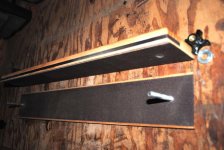tangimango
Well-known member
im having the hardest time trying to join a bookmatch top.
what method do you guy use for a gap free joint?
ive only used the sandpaper on flat board method and is not working for me. i can do it with thicker boards but this one is around 2.5mm, the thinner it is the harder to joint?
what method do you guy use for a gap free joint?
ive only used the sandpaper on flat board method and is not working for me. i can do it with thicker boards but this one is around 2.5mm, the thinner it is the harder to joint?





